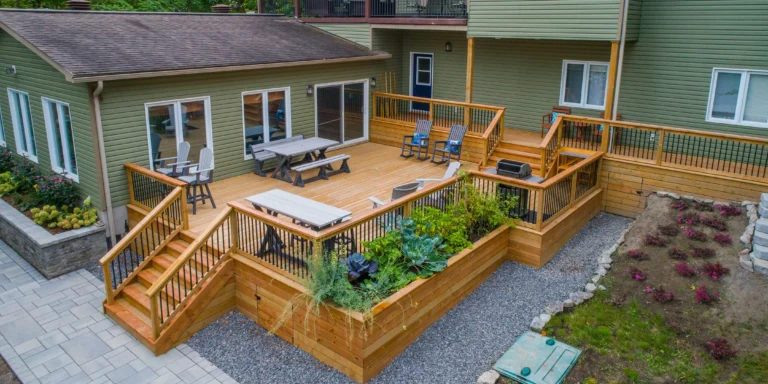Creating an inviting outdoor space starts with selecting the right furniture materials. Whether you’re furnishing a sprawling patio, a cozy balcony, or a charming garden, the choice of materials can significantly impact the aesthetics and durability of your outdoor furniture.
In this guide, we’ll introduce the most commonly used outdoor furniture materials, selection considerations, and common maintenance tips. Read on to learn more.
Things to consider when choosing outdoor furniture materials
Choosing the best material for outdoor furniture is a complex task that deserves our research and learning. In addition to understanding the pros and cons of materials, there are a few basic factors you need to consider. These considerations will help ensure that the chosen materials can withstand the various outdoor elements and provide long-lasting durability. Let’s dive into the details of each factor:
Local Climate Conditions
Outdoor materials must be able to withstand the elements. Consider the climate in your area. Look for materials specifically designed for outdoor use with built-in resistance to moisture, UV rays, rust, and corrosion.
Rainfall & Moisture
If you reside in a region with consistently high rainfall or humidity, it is crucial to select furniture material that is waterproof or moisture-resistant.
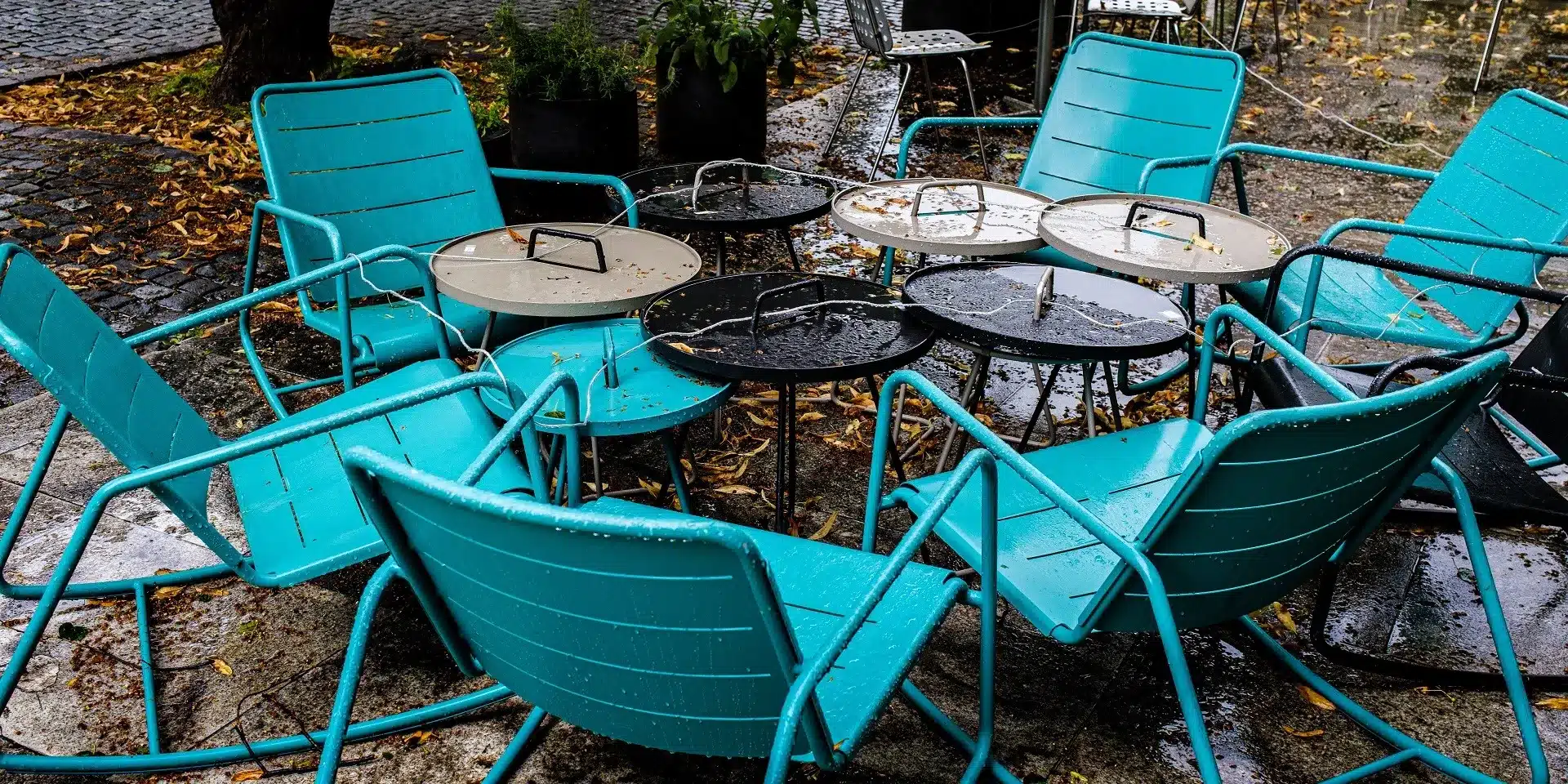
Excessive moisture can create a favorable environment for the growth of mold and mildew, especially when it seeps into outdoor furniture materials like wood or wicker. This leads to material decay, compromises structural integrity, and gives rise to unpleasant odors and health issues.
Continuous exposure to moisture can cause certain materials, like wood, to warp, swell, or discolor. This can result in distorted furniture, making it uncomfortable to use and affecting its overall appearance.
Sunshine Time & Temperature
Suppose you reside in a sunny area or an area with significant seasonal climate changes. In that case, selecting outdoor materials that offer resistance to UV rays and can withstand the repeated cycles of hot and cold temperatures is essential.
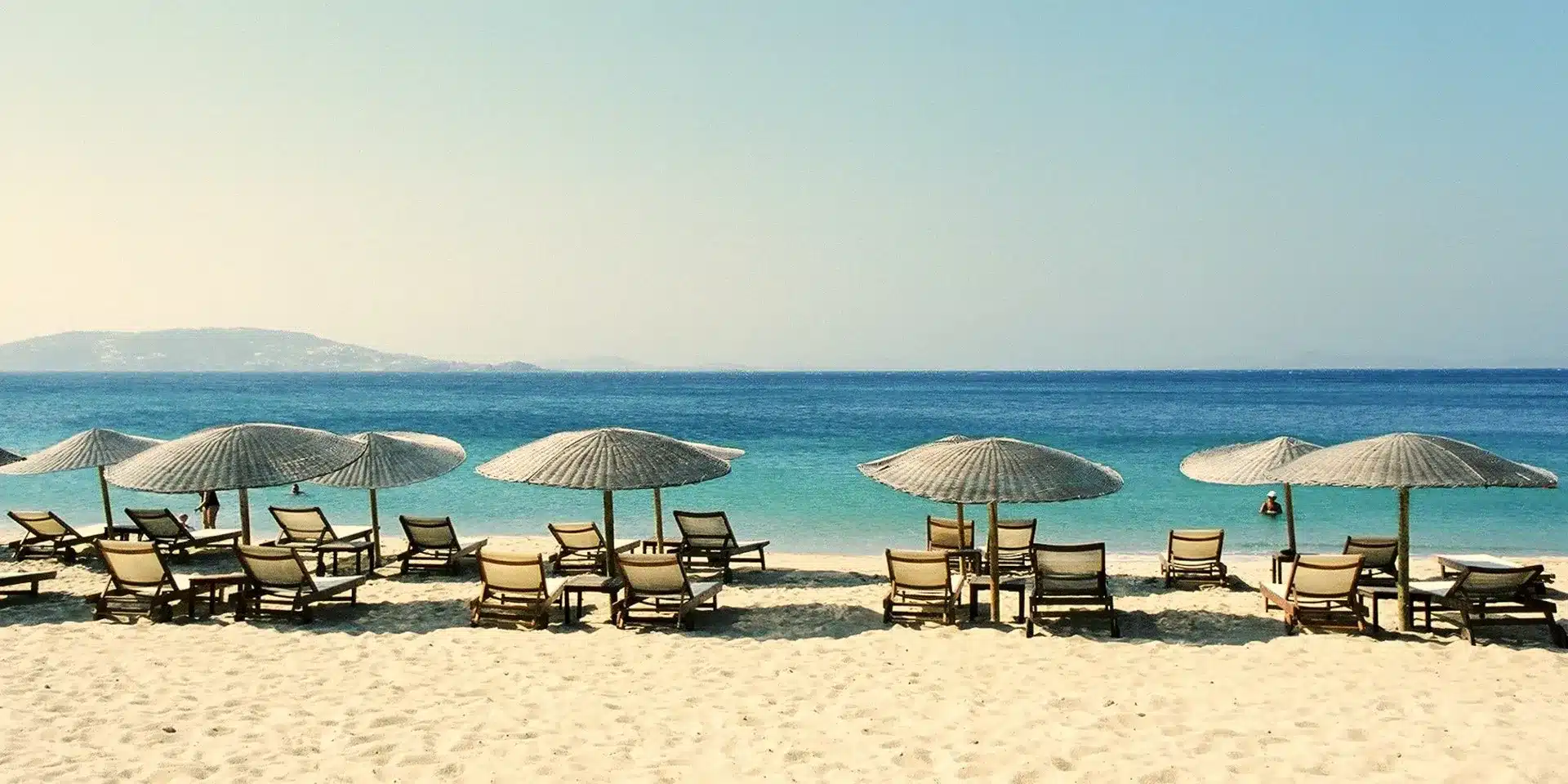
Sunlight’s ultraviolet (UV) rays accelerate the breakdown of pigments, causing fading and aging of materials. Prolonged exposure to intense heat and sunlight can result in the drying out and cracking of wood. Additionally, temperature fluctuations can lead to the expansion and contraction of materials, exerting stress on joints and connections. Over time, this can contribute to instability, loosening, or even breakage.
Extreme heat or cold can also make outdoor furniture uncomfortable to sit on or touch. Metal surfaces, in particular, can become scorching hot, posing a risk of burning your skin without adding cushions or coverings.
Wind & Storms
If you have outdoor furniture in coastal or windy areas, please ensure that the furniture is adequately weighted.
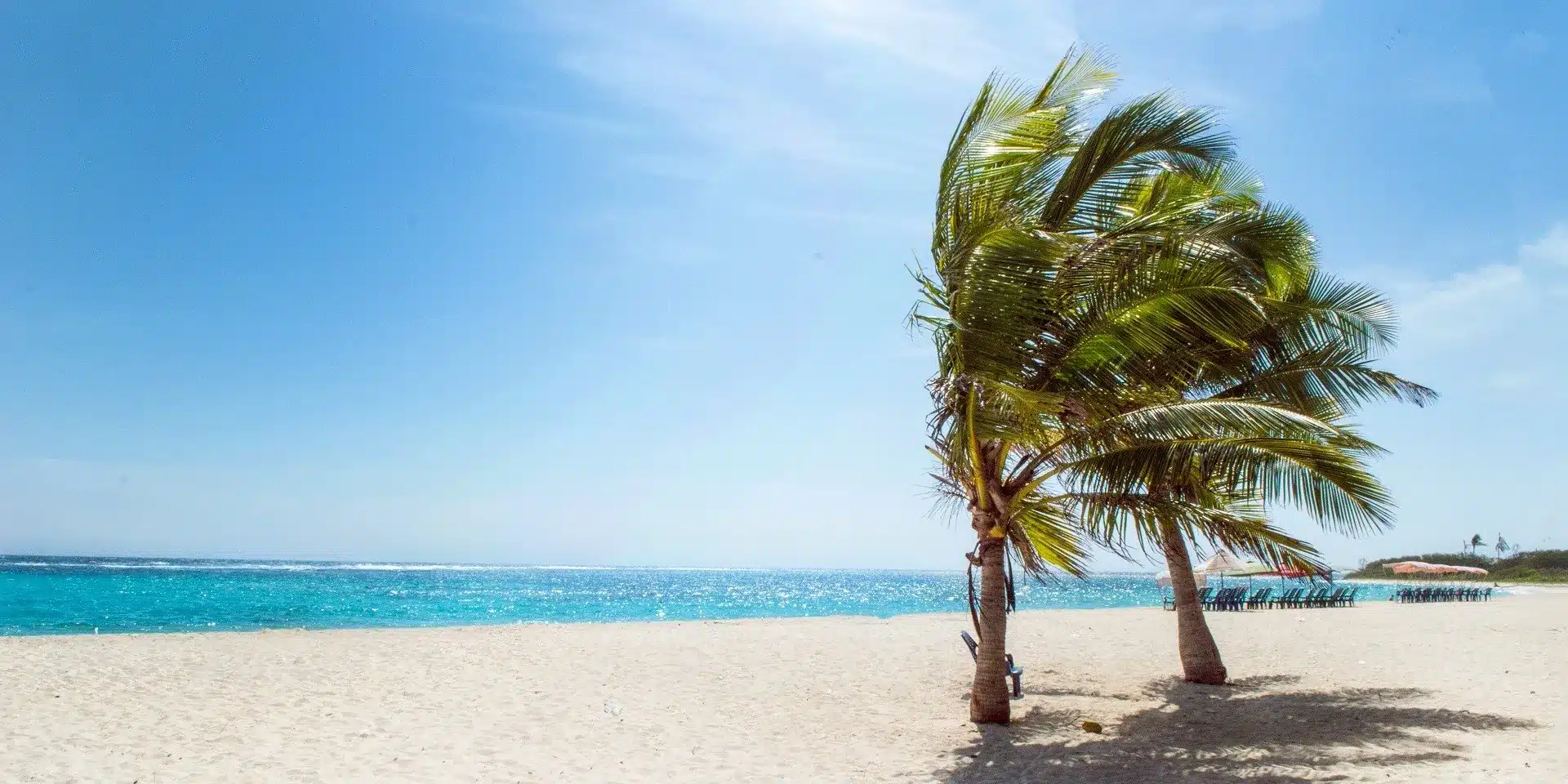
Strong winds can cause lightweight or improperly secured furniture to shift or blow away. Severe storms can cause even greater damage, resulting in furniture toppling over or being tossed around, leading to dents, scratches, or breakage.
Moreover, wind can pick up debris and other loose objects during storms. Flying branches, rocks, or other projectiles can result in chips, dents, or even structural damage to the furniture.
Durability
Outdoor furniture materials should be durable enough to withstand frequent use and last for many years. Assess the material’s strength, resistance to wear and tear, and its ability to maintain structural integrity over time. Consider factors such as impact resistance, flexibility, and resistance to fading, cracking, or warping.
Maintenance Costs
Evaluate the level of maintenance the material requires. For example, wood may require regular sealing or staining, while resin or plastic may only need occasional cleaning. Consider how much time and effort you will dedicate to maintaining the outdoor materials.
Eco-friendly
If sustainability is important to you, consider materials that have a lower environmental impact. Look for materials that are renewable, recycled, or made from sustainable resources. For example, consider using reclaimed wood, recycled plastic, or eco-friendly composite materials for outdoor furniture.
Price
Set a budget for your outdoor furniture and consider the cost of different materials. Prices vary significantly based on the material’s quality, durability, and aesthetic appeal. Remember that investing in high-quality materials upfront can lead to long-term cost savings by reducing the need for frequent replacements or repairs.
Types of Outdoor Furniture Material
With the key factors above, we have made a simple comparison of various materials. You can see in the table which material meets all your requirements. Below we will show you how to choose the best outdoor furniture material. We will briefly introduce each material and analyze its pros and cons. This makes it quick and easy to choose your favorite outdoor furniture materials.
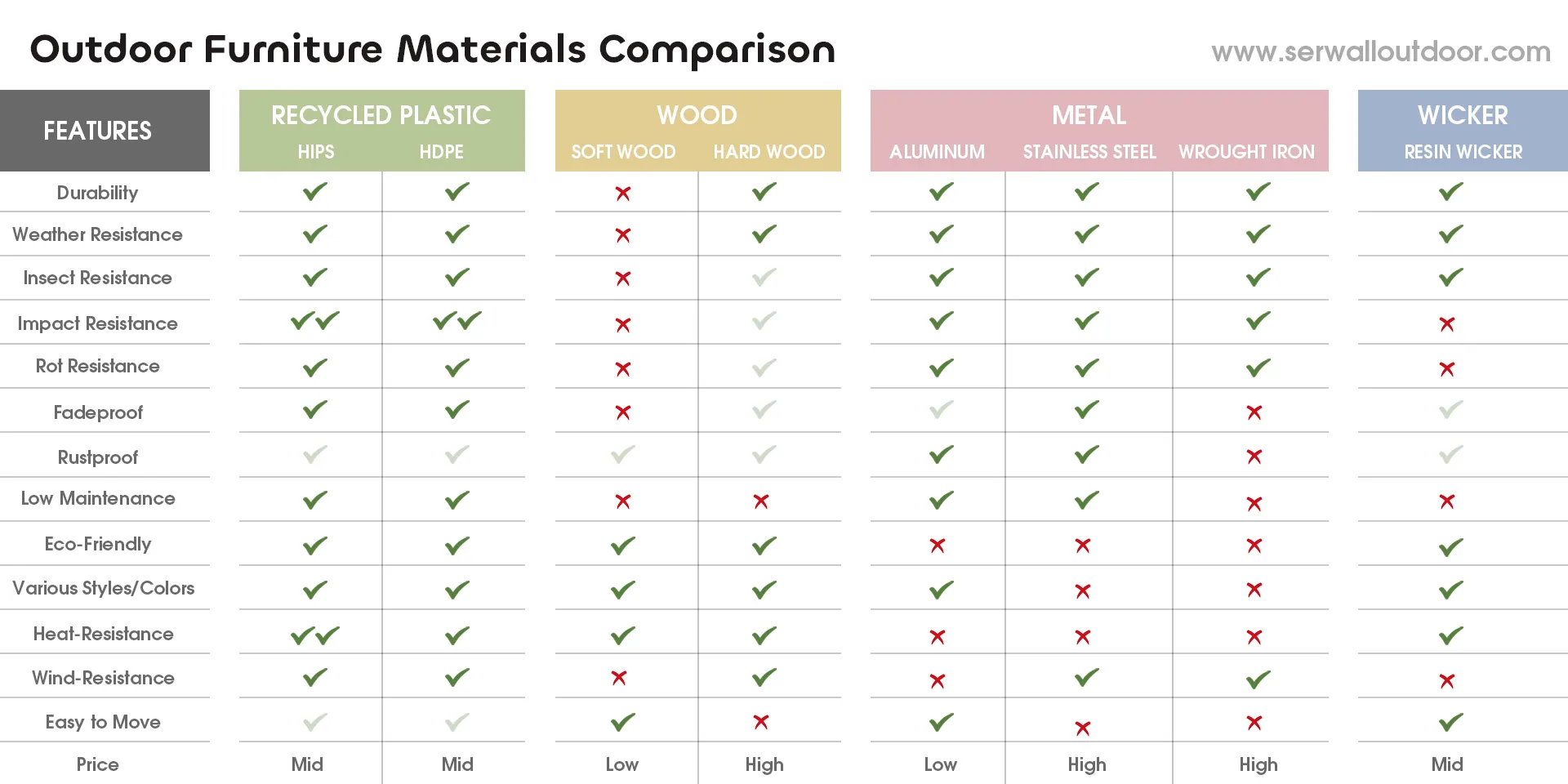
Wood
Wood is a favored option for outdoor furniture due to its natural beauty, durability, and versatility. However, it’s essential to recognize the significant distinctions among various wood types, including the contrasting characteristics of softwood and hardwood.
Softwood
Softwood refers to wood sourced from coniferous trees. It is generally less dense and more affordable than hardwood. However, it is more vulnerable to moisture, insects, and UV rays. Despite this, softwood, such as beautiful pine and cedar, is still suitable for outdoor use with proper treatment and maintenance.
Pine is a lightweight, cost-effective wood that is easy to work with. However, pine furniture may require regular sealing or staining to protect it from moisture and decay.
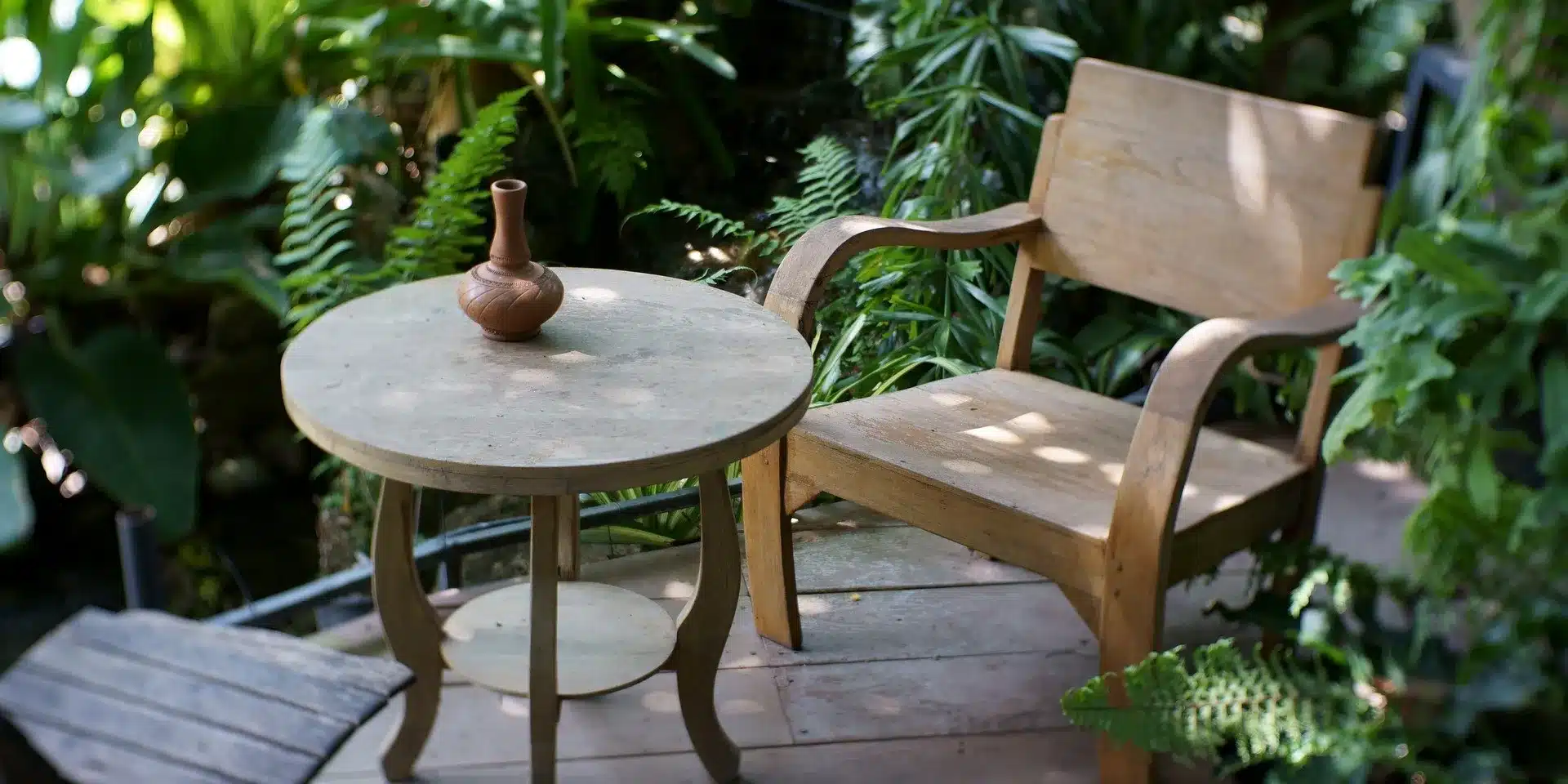
Cedar is renowned for its natural resistance to decay and insects, pleasant aroma, and attractive grain patterns. However, due to its softness, cedar is prone to dents. It can also accumulate moisture, leading to potential cracking issues.
Pros
- Ich Texture
- Retro and Elegant Appearance
- Renewable
- Cost-effective
- Lightweight
Cons
- Poor Durability
- Soft Material
- Easy to Decay and Insect Infestations
- High Maintenance Cost
Hardwood
Hardwood, derived from deciduous trees, is denser and more durable than softwood. It offers excellent longevity and resistance to the elements. Hardwood used in outdoor furniture includes teak, ipe, eucalyptus, oak, shorea, etc.
Teak is highly durable and weather resistant. Its natural oils provide resistance to rot, decay, and insect infestation. Teak furniture weathers beautifully over time, developing an attractive silver-gray patina. It requires minimal maintenance, making it a sought-after choice for outdoor settings.
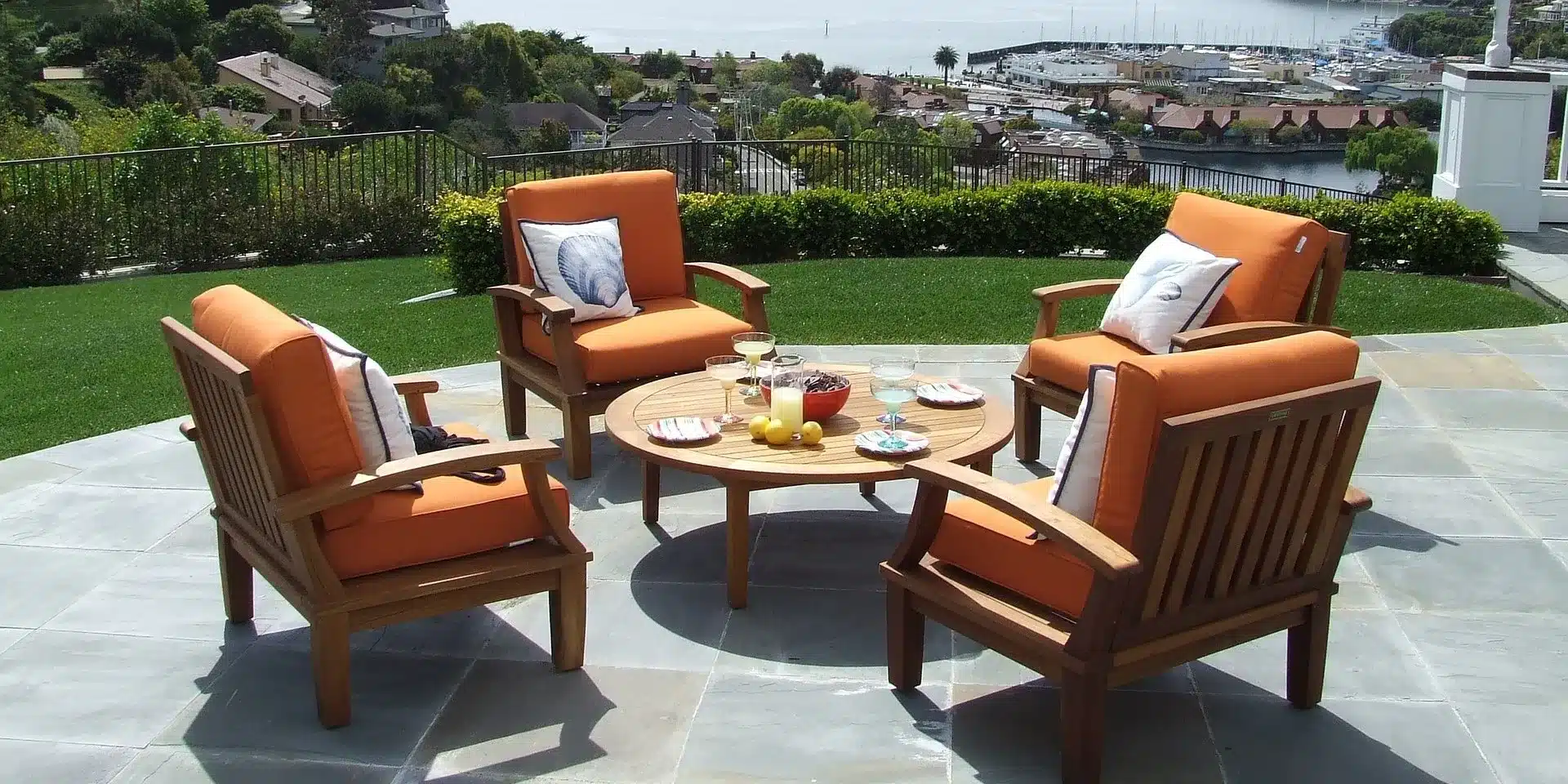
Ipe, also known as Brazilian Walnut, is renowned for its extreme hardness and durability. It has excellent resistance to rot, insects, and harsh weather conditions. Ipe furniture has a rich brown color and a fine, straight grain.
Pros
- Durable
- Sturdy
- Weather-resistant
- Long-lasting
- Fadeproof
Cons
- More Expensive
- Heavy
- Require Regular Maintenance
Metal
Metal materials are popular choices for outdoor furniture. Aluminum, stainless steel, and wrought iron provide long-lasting performance and can withstand various outdoor conditions.
Aluminum
Aluminum is frequently used to create outdoor dining sets, patio sofas, and side tables. Because of its strength, durability, and rust resistance, this material is perfect for usage in coastal areas or near seawater. Outdoor aluminum furniture usually has a protective paint or powder coating on the finish. It can be combined with wicker and wood to create diverse design styles.

Pros
- Cheap
- Lightweight
- Durable
- Rust and Corrosion Resistant
- Low-maintence
Cons
- Poor Stability
- Easy to get hot under the sun
- Material Too Cold
Stainless Steel
Stainless steel is highly corrosion-resistant, making it ideal for outdoor use. It can withstand exposure to moisture, rain, and harsh weather conditions without rusting or deteriorating. With its exceptional strength, it can bear heavy loads and withstand impacts. Low maintenance requirements and easy cleaning contribute to its appeal.

However, stainless steel can retain heat when exposed to direct sunlight, making it uncomfortable to sit on without cushions or shade. Its substantial weight can pose challenges in terms of mobility.
Pros
- Durable
- Corrosion-resistant
- Weather-resistant
- Low-maintenance
Cons
- More expensive
- Heavy
- Heat-retaining
Wrought Iron
Wrought iron is a durable material created by heating and shaping iron into intricate designs. It can withstand harsh weather conditions, such as rain, wind, and sun exposure, without compromising its structural integrity. It can also support heavy weights and withstand regular use.
However, wrought iron furniture may require occasional maintenance to prevent rusting. It is relatively heavier than other materials, which may limit its portability.
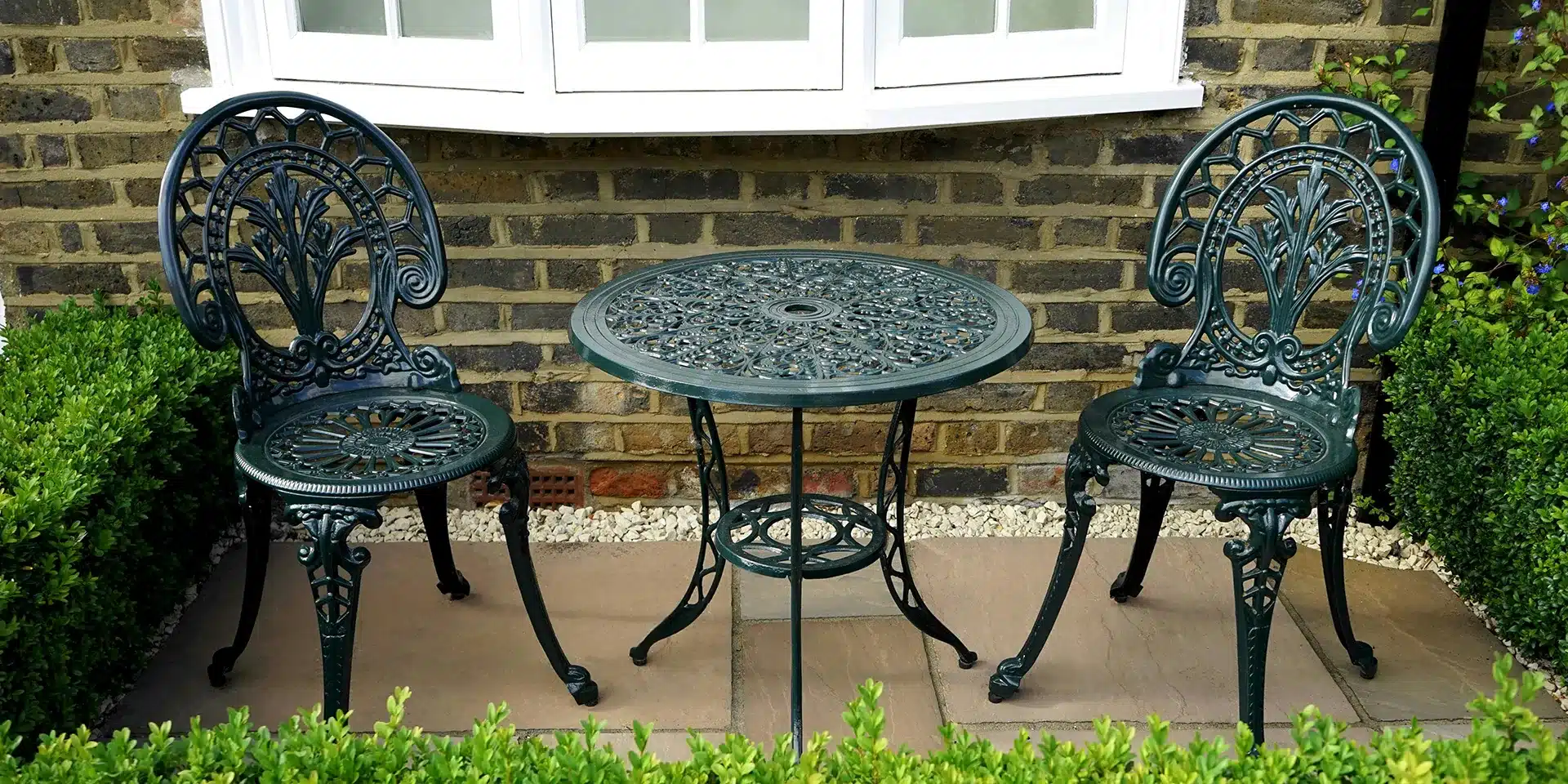
Pros
- Sturdy
- Durable
- Weather-resistant
- High load-bearing
Cons
- Expensive
- Inconvenient to Move
- High Maintenance Cost
- Easy to Rust
Synthetic Resin Wicker
Resin wicker, also known as all-weather or synthetic wicker, is crafted from synthetic fibers, typically polyethylene, intricately woven to mimic the appearance and texture of natural wicker. Resin wicker surpasses natural wicker in its resistance to environmental factors such as moisture, UV rays, and temperature fluctuations. Still, it may experience gradual wear over time. Compared to solid wood or wrought iron, resin wicker furniture is lightweight, making it easier to move or rearrange as desired.
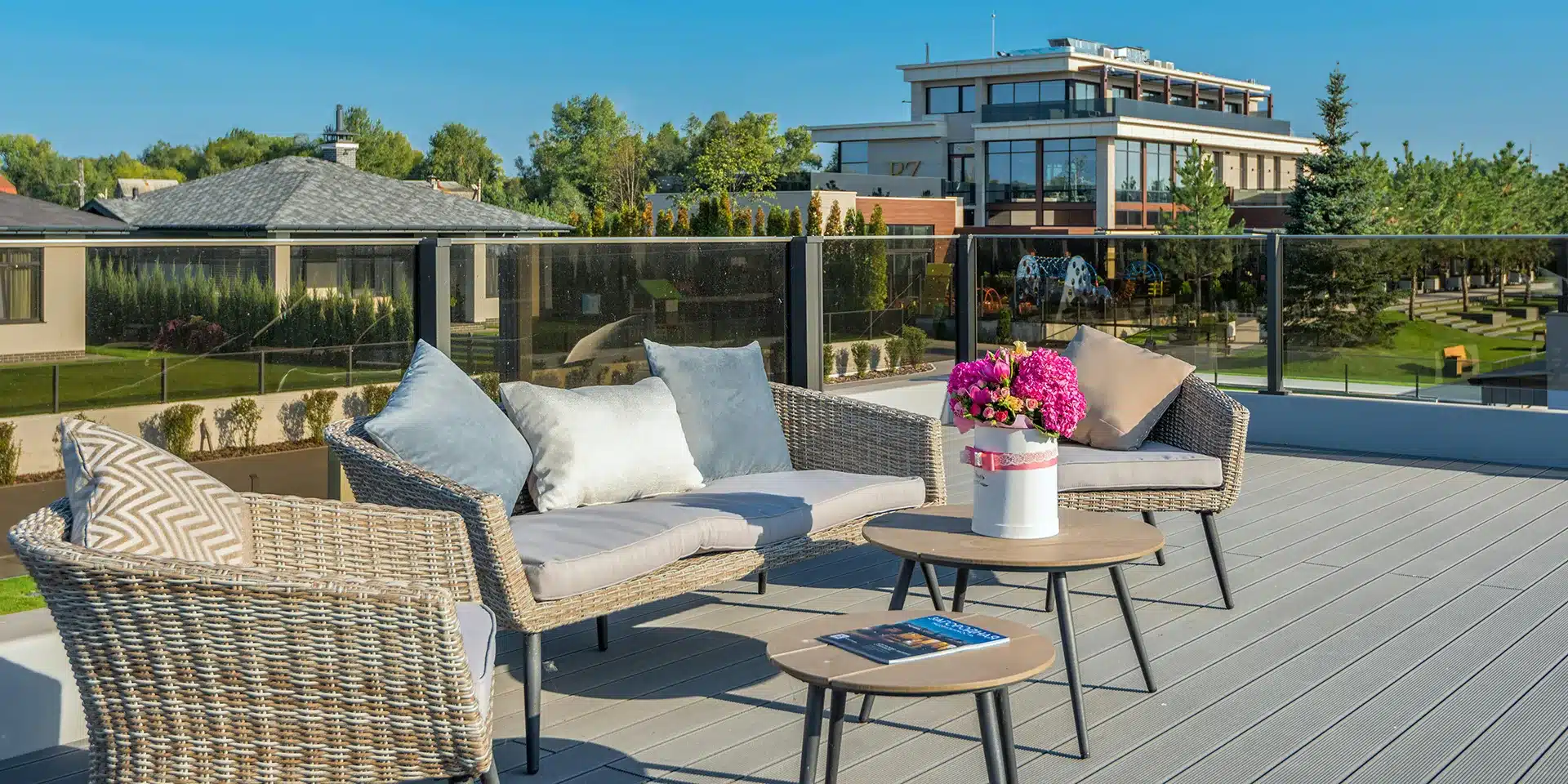
A wide selection of styles, colors, and weaves is available, catering to diverse outdoor aesthetics. However, it is worth noting that wicker furniture’s crevices tend to accumulate dust, necessitating additional cleaning time and effort.
Pros
- Lightweight
- Various Styles and Designs
- Weather-resistant
- Eco-friendly
Cons
- Prone to cracking or breaking after long-term use
- High Maintenance Cost
- Poor Stability
Plastic
Plastic materials are popular for outdoor furniture due to their durability, weather resistance, and low maintenance requirements.
Recycled Plastic
Recyclable plastics can be collected, processed, and reused in the production of new items, reducing waste and conserving resources. Two commonly used plastic materials for eco-friendly outdoor furniture are High-Density Polyethylene (HDPE) and High Impact Polystyrene (HIPS).
High-Density Polyethylene (HDPE)
HDPE is a popular recycled plastic material for outdoor furniture. It is derived from post-consumer plastic waste, such as plastic bottles or containers.
Renowned for its strength and durability, HDPE is an excellent choice for outdoor applications. It exhibits remarkable resilience against heavy usage and impact, minimizing the risk of breakage.
Moreover, HDPE showcases exceptional resistance to harsh weather conditions, such as sunlight, rain, and snow, making it highly resilient to fading, cracking, or warping when exposed to the elements.

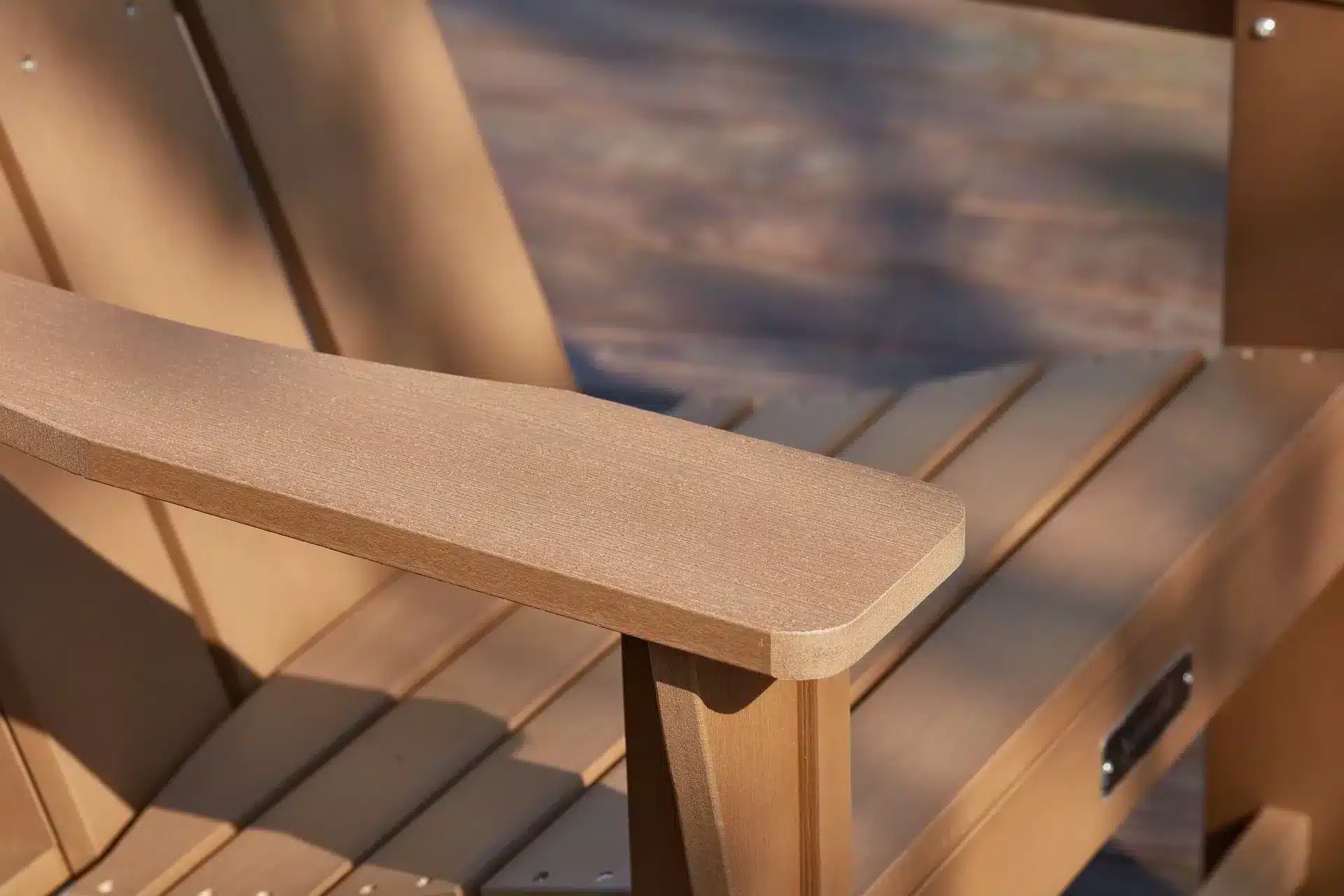
High Impact Polystyrene (HIPS)
Similar to HDPE, HIPS is also recyclable.
HIPS is a rigid plastic known for its exceptional impact resistance. The high impact strength makes it withstand rough handling and protect against damage from impacts or heavy loads.
It is also resistant to moisture and UV rays, ensuring its longevity in outdoor environments. HIPS can be easily molded into various shapes and designs, allowing for creative and intricate outdoor furniture designs.
Both HDPE and HIPS offer advantages in terms of durability, weather resistance, and recyclability. They are low-maintenance and resistant to fading, rot, and insect infestation. With various colors and designs, recycled plastics provide flexibility in style and aesthetics.The pros and cons are as follows:
Pros
- Sustainable and Recyclable
- Durable
- Weather-resistant
- Impact-resistant
- Low-maintenance
- Fadeproof
Cons
- Higher Price
- The material looks slightly worse than solid wood
Other Plastics
Polypropylene (PP) is lightweight, durable, and resistant to impact and weather conditions. PP plastic furniture is easy to clean and often features contemporary designs.
Polycarbonate (PC) is a strong and transparent plastic used for outdoor furniture, particularly in applications where transparency is desired, such as clear chairs or tabletops.
Acrylic is a clear and lightweight plastic often used for outdoor furniture, particularly for its visual appeal and weather resistance. It is available in various colors and can mimic the appearance of glass.

Outdoor Furniture Upholstery Materials
Upholstery materials refer to the fabrics or coverings used to upholster furniture, such as sofas, chairs, and ottomans. They significantly impact the overall look, comfort, and durability of the furniture.
Common upholstery materials include fabrics like cotton, linen, polyester, microfiber, leather, and synthetic blends. Each upholstery material possesses distinct qualities, such as breathability, texture, resistance to staining, and ease of maintenance. The choice of upholstery material depends on personal preference, the intended use of the furniture, and the desired aesthetic style.
Acrylic

Olefin
Olefin, recognized for its strength and colorfastness, is also resistant to fading, staining, and mildew. Additionally, it boasts quick-drying properties and ease of cleaning, rendering it well-suited for outdoor cushion covers.

Polyester
Polyester is ideal for furniture covers as it is lightweight, affordable, and exhibit resistance to water and UV rays. They provide decent protection against dust, dirt, and light rain. Solution-Dyed Polyester, combining the strength of polyester with solution-dyed technology, ensures excellent color retention, resistance to fading, and protection against UV damage. It offers long-lasting safeguarding for outdoor furniture.
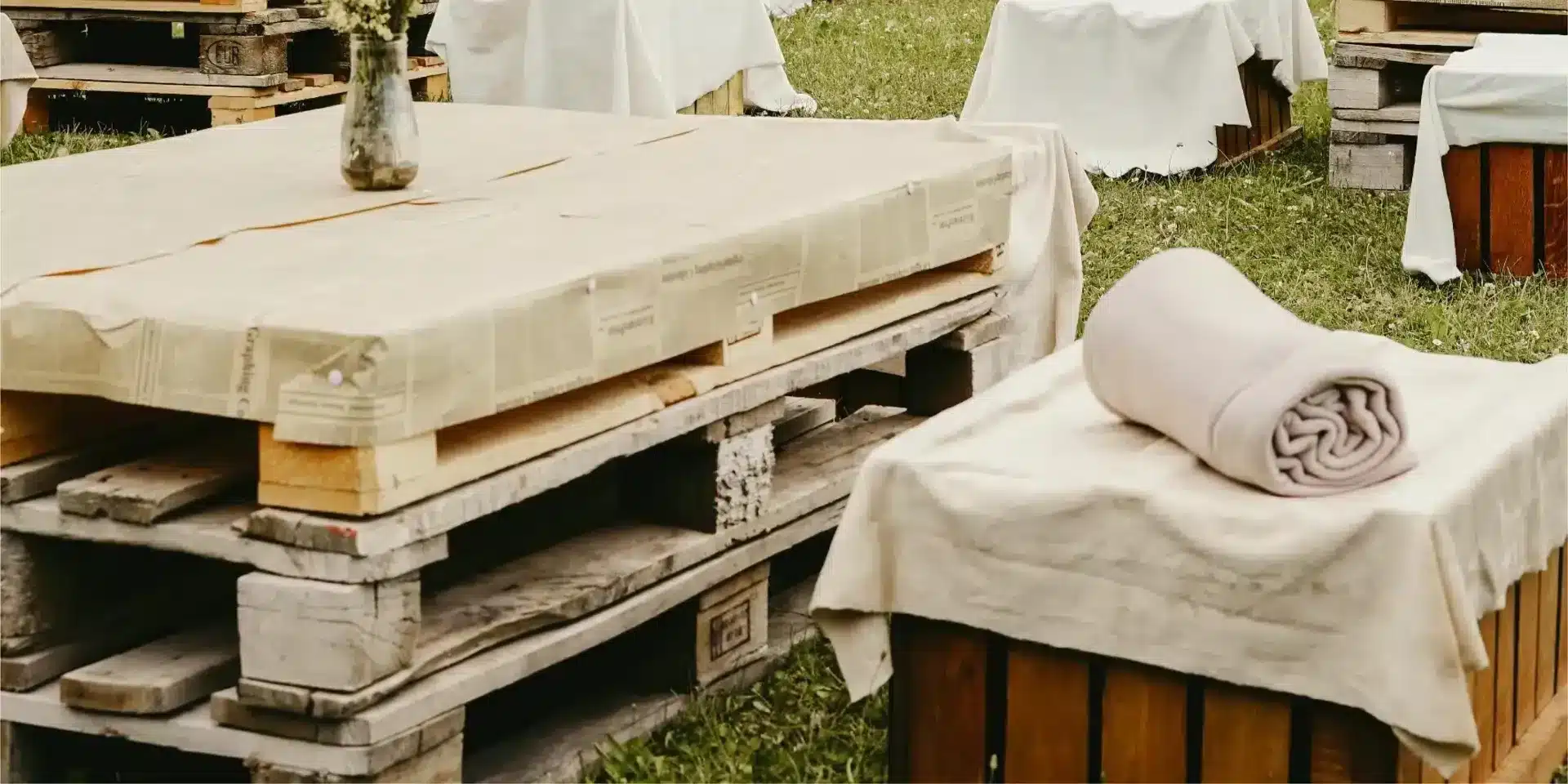
Maintenance Tips
Regular maintenance and cleaning of outdoor furniture is crucial to preserve its appearance, durability, and longevity. Proper care helps prevent damage from weather elements, prolongs the lifespan of the furniture, and ensures a clean and inviting outdoor space for relaxation and enjoyment.
Below are maintenance tips for each type of outdoor furniture materials.
Wood Material
It’s vital to consider the specific needs of your wood type and the environmental conditions it will be exposed to when selecting a protective stain or sealant. Always follow the manufacturer’s instructions for proper application and reapplication to ensure adequate protection and maintenance of the wood finish.

Varnish
Varnish is a popular choice for protecting wood surfaces. It forms a rugged and durable coating that helps to shield the wood from moisture, UV rays, and general wear and tear. Varnish comes in different sheens, including gloss, semi-gloss, and matte. But it can be challenging to apply evenly without leaving brush marks or streaks.
Polyurethane
Polyurethane is another common choice for wood protection. It creates a strong, clear finish that provides excellent resistance to scratches, spills, and other forms of damage. Polyurethane is available in oil-based and water-based formulas, with varying levels of glossiness. Oil-based polyurethane has a longer drying time compared to water-based polyurethane.
Lacquer
Lacquer provides a hard and durable finish that dries quickly. It offers good resistance to water, chemicals, and general wear. Lacquer is available in various sheens and can create a smooth, high-gloss appearance. It may be yellowing over time.
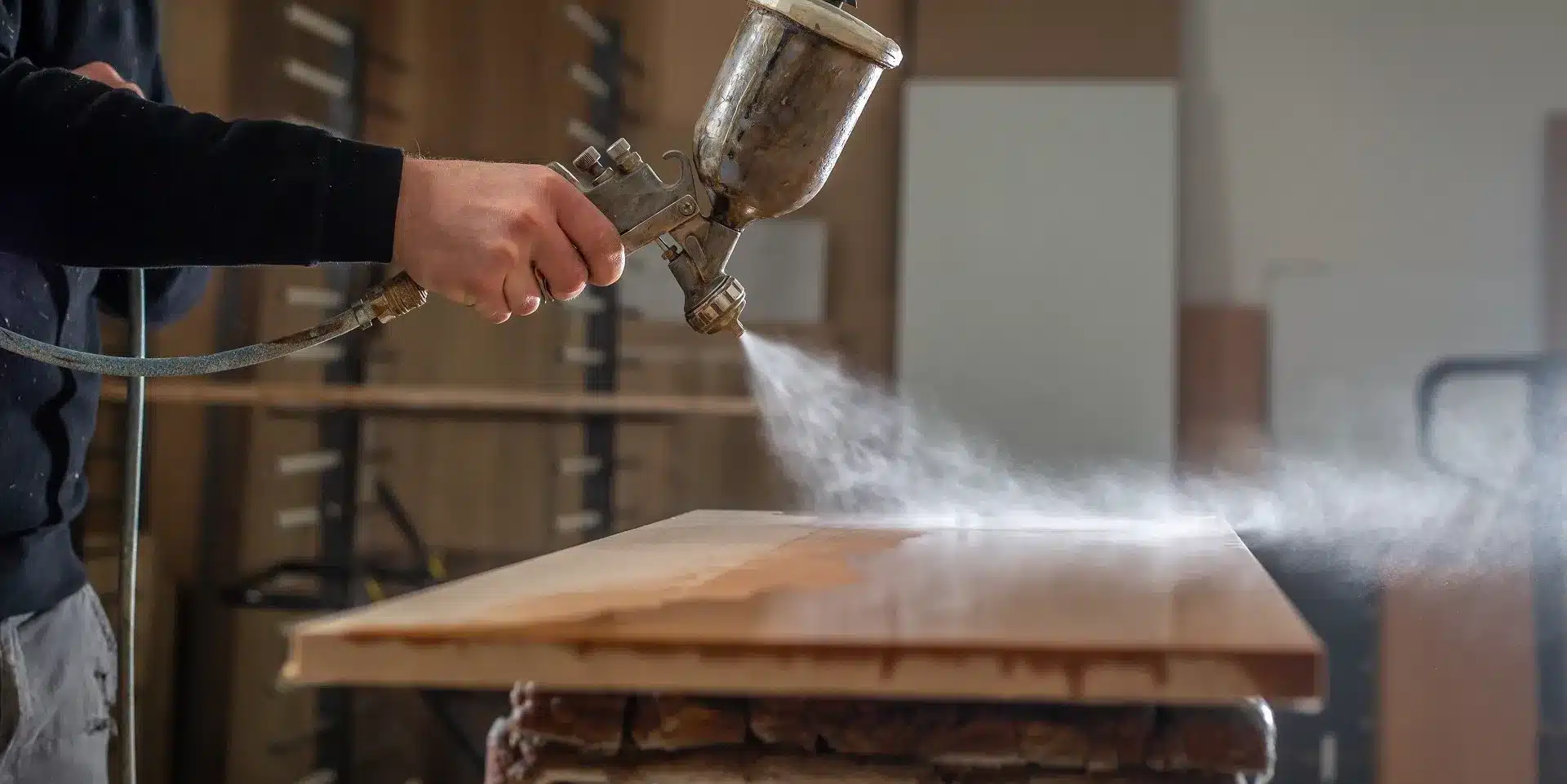
Exterior Oil-Based Stains
These stains penetrate the wood and provide a natural appearance while offering protection against moisture and UV damage. They enhance the wood’s grain and are suitable for outdoor applications. It may require more frequent maintenance and reapplication compared to film-forming finishes.
Water-Based Stains
Water-based stains are environmentally friendly and dry quickly. They offer good color retention and protect against fading and mildew. They are a suitable option for both interior and exterior wood finishes. However, it can result in a less pronounced grain appearance compared to oil-based stains.
Metal Meteial
Each metal coating option has its strengths and weaknesses, and the ideal choice depends on factors such as the type of metal, desired appearance, budget, and environmental conditions. Consider consulting with professionals or specialists in metal coatings to determine the most suitable option for your outdoor furniture.

Powder Coating
Powder coating is a high-quality method that involves the application of a dry powder onto metal surfaces, followed by a heating process to create a robust and protective layer. This technique provides exceptional durability and resistance against scratches, fading, and corrosion. However, due to the requirement for specialized equipment and expertise during the application, powder coating may be comparatively more expensive than alternative coating options.
Galvanizing
Epoxy Coating
Epoxy coatings provide a rugged and protective layer to metal surfaces. They offer excellent resistance to chemicals, UV rays, and abrasion. Epoxy coatings can enhance the lifespan of outdoor furniture by preventing rust and corrosion.

Clear Coats
Clear coats are transparent protective coatings applied to metal surfaces. They provide a glossy finish and protect the metal from oxidation, UV damage, and corrosion. Clear coats are commonly used to preserve the natural appearance of metal furniture.
Anodizing
Anodizing is a highly effective process that forms a durable oxide layer on the surface of aluminum. This coating enhances the metal’s resistance to corrosion, abrasion, and fading. However, anodizing offers limited color options, predominantly in shades of silver.
Plastic Material
While HDPE, HIPS, and resin wicker are weather-resistant, additional treatments and maintenance can enhance their longevity and appearance.
Regularly clean the furniture with a soft brush or cloth to remove dust, dirt, mildew,and debris. You can also use a mild soap solution and water for more thorough cleaning. Avoid using abrasive cleaners or brushes that can scratch the surface of the furniture. After cleaning, rinse the furniture thoroughly to remove any residue.
During the winter season or extended periods of non-use, it is advisable to provide protection by using covers or storing the furniture indoors. This precaution safeguards against extreme cold, freezing temperatures, and potential damage.

Remember to refer to the manufacturer’s instructions and guidelines for your outdoor furniture. Different brands and products may have their own recommendations for care and maintenance. Following proper care practices can extend the lifespan and keep your furniture looking its best.
The Verdict
So,what is best material for outdoor furniture?Solid wood, plastic, and metal are all high-quality outdoor furniture materials. You need to choose according to your preferences and actual needs.
For those seeking durability, weather resistance, and low maintenance, HDPE and HIPS materials are excellent choices. These materials offer exceptional resistance against the elements and require minimal upkeep. The abundant array of colors and styles ensures you can find the ideal match.

If a classic and elegant look is desired, natural woods like teak and cedar are highly recommended. They showcase natural beauty, strength, and resistance to decay, ensuring longevity in outdoor furniture.
Resin wicker is an ideal choice for those desiring lightweight, modern, and visually appealing furniture.
For cost-effective metal furniture, aluminum is a wise option.
FAQs – Outdoor Furniture Materials
Metal, particularly aluminum or wrought iron, is often considered the most durable material for outdoor patio furniture. It is highly resistant to weather conditions, does not rot or warp, and can withstand years of use without significant damage. Regular maintenance and proper care can further extend its lifespan.
For humid weather, it is recommended to choose outdoor furniture made from materials that are resistant to moisture and mold growth. Aluminum, teak, and certain types of plastics, such as high-density polyethylene (HDPE), are popular choices. These materials can withstand the humidity without warping, rotting, or developing mold, making them suitable for humid climates.
Expensive outdoor furniture, particularly those made from durable materials like HDPE, can be worth the investment. HDPE is a durable and long-lasting material that is resistant to moisture, fading, and cracking. It’s weather-resistant, requiring minimal maintenance.
Despite the initial higher cost, HDPE furniture offers long-term benefits in terms of extended lifespan and reduced maintenance. This makes it a valuable investment for individuals looking for durable and high-quality outdoor furniture.
The lifespan of outdoor furniture varies by material. Well-maintained wood furniture can last 10-15 years, while metal furniture can last 10-20 years. Synthetic wicker furniture typically lasts 5-10 years, and high-quality plastic furniture can last 10-20 years or more, depending on the material’s quality.


